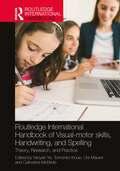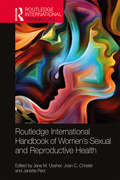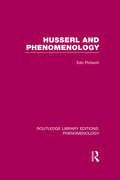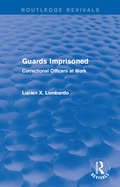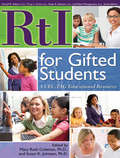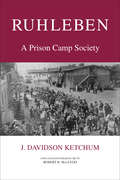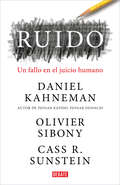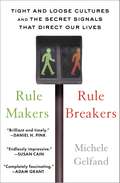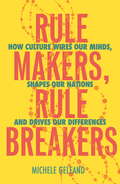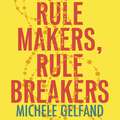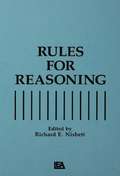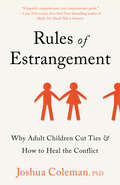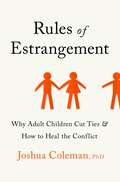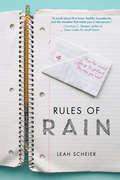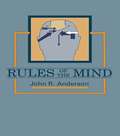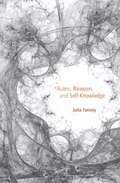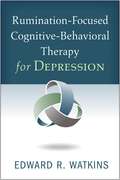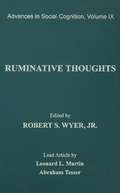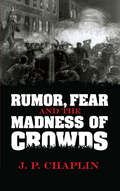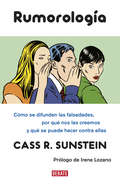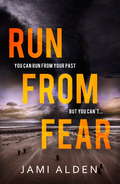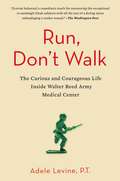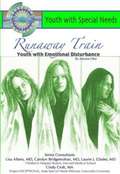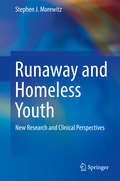- Table View
- List View
Routledge International Handbook of Visual-motor skills, Handwriting, and Spelling: Theory, Research, and Practice (Routledge International Handbooks)
by Catherine McBride Yanyan Ye Tomohiro Inoue Urs MaurerThe Routledge International Handbook of Visual-motor skills, Handwriting, and Spelling explores the potentially controversial field of early literacy education. It aims to offer scholars and practitioners an analysis of how and why handwriting skills benefit early literacy learning, especially spelling acquisition, and how this can enrich experiences for children and educators. Offering global perspectives from the field, the volume integrates current theories with up-to-date research and practice, revealing how we can best support children’s early literacy learning with handwriting and visual-motor skills interventions. Key topics covered include: The fundamentals of handwriting skills and literacy acquisition; Global literacy and spelling; Dysgraphia, handwriting difficulties, and dyslexia; Spelling and writing in the digital age; Home learning environment and spelling; Instruction and interventions for spelling and writing. This comprehensive survey will be essential reading for scholars and students of developmental psychology, education, and literacy research.
Routledge International Handbook of Women's Sexual and Reproductive Health (Routledge International Handbooks)
by Joan C. Chrisler Jane M. Ussher Janette PerzThe Routledge International Handbook of Women’s Sexual and Reproductive Health is the authoritative reference work on important, leading-edge developments in the domains of women’s sexual and reproductive health. The handbook adopts a life-cycle approach to examine key milestones and events in women’s sexual and reproductive health. Contributors drawn from a range of disciplines, including psychology, medicine, nursing and midwifery, sociology, public health, women’s studies, and indigenous studies, explore issues through three main lenses: the biopsychosocial model feminist perspectives international, multidisciplinary perspectives that acknowledge the intersection of identities in women’s lives. The handbook presents an authoritative review of the field, with a focus on state-of-the-art work, encouraging future research and policy development in women’s sexual and reproductive health. Finally, the handbook will inform health care providers about the latest research and clinical developments, including women’s experiences of both normal and abnormal sexual and reproductive functions. Drawing upon international expertise from leading academics and clinicians in the field, this is essential reading for scholars and students interested in women’s reproductive health.
Routledge Library Editions: Phenomenology (Routledge Library Editions: Phenomenology)
by VariousReissuing works originally published between 1970 and 1995, Routledge Library Editions: Phenomenology (14 volume set) offers a selection of scholarship covering this important branch of philosophy and method. Volumes cover theories of Husserl and Heidegger, and branch out to such topics as psychology, Marxism, language and emotion, and education, forming a varied and informative collection of previously out-of-print works.
Routledge Revivals (1989): Correctional Officers at Work
by Lucien X. LombardoFirst published in 1989, Guards Imprisoned provides an in-depth look into the work and working life of prison guards as they perceive and experience it. The author, who was a teacher at Auburn Prison, New York, discovered that little was known about the guard’s perceptions of his "place" in the prison community and set out to explore the dynamics of this key correctional occupation from the perspective of those who do it. The raw data was provided by over 160 hours of interviews with guards and is presented in the order of a "natural history" — from their prerecruitment images of prison to the search for satisfaction as experienced guards. The book also includes a follow-up with the officers who were originally interviewed in 1976, assessing patterns of change and stability in their attitudes and behaviors. The Auburn Correctional Facility (renamed from Auburn Prison in 1970) was the second state prison in New York, the site of the first execution by electric chair in 1890, and the namesake of the famed "Auburn System" replicated across the country, in which people worked in groups during the day, were housed in solitary confinement at night, and lived in total silence. The facility is celebrating the 200th anniversary of its groundbreaking in 2016.
RtI for Gifted Students: A Cec-tag Educational Resource
by Mary Ruth Coleman Susan K. JohnsenRtI for Gifted Students provides a comprehensive overview of Response to Intervention (RtI) frameworks that include gifted students. One of the books featured in the CEC-TAG Educational Resource series, the book incorporates national, state, and local RtI models and how gifted learners can be included within these frameworks. Specific attention is given to addressing the needs of students who are twice-exceptional and to culturally responsive practices. The book concludes with ways of assessing a school's RtI model and challenges for using RtI in gifted education.
Ruhleben: A Prison Camp Society (Heritage)
by J. Davidson KetchumThis is an unusual book in that it is an important contribution to social psychology and also an absorbing story of four strange years in a German prison camp of World War I. Four thousand men and boys from the most varied walks of life—professors, seamen, jockeys, schoolboys, bank directors, musicians, clerks, scientists—were taken from civilian life and placed in Ruhleben on the outbreak of war; no activities were prescribed for them, no direction was given to their communal life. In the event, this miscellaneous group of people, closed off from the world, create d their own society. This book is the story of how they did it and what the society they made was like; much more than this, the camp provides a gifted and sympathetic social psychologist with a rare opportunity for study and analysis of an important if inadvertent social experiment. The time elapsed between the event itself and the completion of the book may in one way be regretted; it did, however, allow the author, who was himself and inmate of Ruhleben, the opportunity for mature reflection on its meaning. The book is a contribution to the history of World War I; it is also a basic and timeless study of the dynamics of individual and group behaviour.
Ruido: Un fallo en el juicio humano
by Cass R. Sunstein Daniel Kahneman Olivier SibonyPARA ENTENDER CÓMO PENSAMOS Y PENSAR MEJOR, HAY QUE LEER A KAHNEMAN Premio Nobel de Economía Dos médicos en la misma ciudad pueden dar diagnósticos diferentes a pacientes idénticos; dos jueces pueden dictar sentencias distintas ante delitos similares; nosotros mismos podemos decidir una cosa u otra según sea por la mañana o por la tarde, o según se acerque o no la hora de comer. Estos son ejemplos de ruido: el sesgo que conlleva variabilidad en juicios que deberían ser iguales. El ruido está presente en todas las decisiones individuales y colectivas, y produce errores en innumerables terrenos, desde la medicina hasta la economía, pasando por el derecho, la sanidad, la protección infantil y la contratación. Además, también nos importuna e influye a la hora de tomar muchas de nuestras decisiones cotidianas. Daniel Kahneman, uno de los psicólogos más importantes del mundo, junto con Cass R. Sunstein y Olivier Sibony, dos eminencias mundiales en pensamiento estratégico, nos enseñan a escuchar ese ruido, cuyo impacto tendemos a ignorar, y a reducirlo para mejorar nuestros juicios. Basado en el mismo tipo de análisis agudo e ingeniosos ejemplos que convirtió Pensar rápido, pensar despacio en un best seller internacional, Ruido ofrece una serie de remedios originales, prácticos y sencillos para pensar mejor. La crítica ha dicho:«Una investigación absolutamente brillante de un problema social inmenso que nos ha pasado desapercibido cuando ha estado siempre ante nuestros ojos.»Steven Levitt, autor de Freakonomics «Monumental y apasionante. Excepcional.»The Sunday Times «Un tour de force de sabiduría y claridad.»The New York Times «Puede que Ruido sea el libro más importante que he leído en más de una década. Una obra maestra.»Angela Duckworth, autora de Grit «Un logro magistral y un hito en el campo de la psicología.»Philip E. Tetlock, coautor de Superpronosticadores «Una exploración electrizante de la mente humana. Este libro cambiará permanentemente nuestra forma de pensar sobre la escala y el alcance de los prejuicios.»David Lammy, diputado por Tottenham «Prepárate para que algunas de las mentes más brillantes del mundo te ayuden a repensar tu forma de evaluar a las personas, tomar decisiones y resolver problemas.»Adam Grant, autor de Think Again y presentador del TED podcast WorkLife
Rule Makers, Rule Breakers: How Tight and Loose Cultures Wire Our World
by Michele GelfandA celebrated social psychologist offers a radical new perspective on cultural differences that reveals why some countries, cultures, and individuals take rules more seriously and how following the rules influences the way we think and act.In Rule Makers, Rule Breakers, Michele Gelfand, &“an engaging writer with intellectual range&” (The New York Times Book Review), takes us on an epic journey through human cultures, offering a startling new view of the world and ourselves. With a mix of brilliantly conceived studies and surprising on-the-ground discoveries, she shows that much of the diversity in the way we think and act derives from a key difference—how tightly or loosely we adhere to social norms. Just as DNA affects everything from eye color to height, our tight-loose social coding influences much of what we do. Why are clocks in Germany so accurate while those in Brazil are frequently wrong? Why do New Zealand&’s women have the highest number of sexual partners? Why are red and blue states really so divided? Why was the Daimler-Chrysler merger ill-fated from the start? Why is the driver of a Jaguar more likely to run a red light than the driver of a plumber&’s van? Why does one spouse prize running a tight ship while the other refuses to sweat the small stuff? In search of a common answer, Gelfand spent two decades conducting research in more than fifty countries. Across all age groups, family variations, social classes, businesses, states, and nationalities, she has identified a primal pattern that can trigger cooperation or conflict. Her fascinating conclusion: behavior is highly influenced by the perception of threat. &“A useful and engaging take on human behavior&” (Kirkus Reviews) with an approach that is consistently riveting, Rule Makers, Ruler Breakers thrusts many of the puzzling attitudes and actions we observe into sudden and surprising clarity.
Rule Makers, Rule Breakers: Tight and Loose Cultures and the Secret Signals That Direct Our Lives
by Michele J. Gelfand'A groundbreaking analysis of what used to be an impenetrable mystery: how and why do cultures differ? ... Anyone interested in our cultural divides will find tremendous insight in Rule Makers, Rule Breakers' - Steven Pinker, Johnstone Professor of Psychology, Harvard University, and author of Enlightenment NowWhy are clocks in Germany always correct, while those in Brazil are frequently wrong? Why are Singaporeans jailed for selling gum? Why do women in New Zealand have three times the sex of females worldwide? Why was the Daimler-Chrysler merger ill-fated from the start? And why does each generation of Americans give their kids weirder and weirder names? Curious about the answers to these and other questions, award-winning social psychologist Michele Gelfand has spent two decades studying both tight societies (with clearly stated rules and codes of ethics) and loose societies (more informal communities with weak or ambiguous norms). Putting each under the microscope, she conducted research in more than fifty countries and collaborated with political scientists, neuroscientists, computer scientists, anthropologists, and archaeologists. Her fascinating conclusion: behaviour seems largely dependent on perceived threats. It's why certain nations seem predisposed to tangle with others; some American states identify as "Red" and others as "Blue"; and those attending a sports contest, health club, or school function behave in prescribed ways. Rule Makers, Rule Breakers reveals how to predict national variations around the globe, why some leaders innovate and others don't, and even how a tight vs. loose system can determine happiness. Consistently riveting and always illuminating, Michele Gelfand's book helps us understand how a single cultural trait dramatically affects even the smallest aspects of our lives.'Fascinating and profound...It's quite possibly this year's best book on culture' - Roy F. Baumeister, bestselling co-author of Willpower and author of The Cultural Animal'This brilliant book is full of well-documented insights that will change the way you look at yourself and at the world around you' - Barry Schwartz, bestselling author of The Paradox of Choice, Practical Wisdom, and Why We Work
Rule Makers, Rule Breakers: Tight and Loose Cultures and the Secret Signals That Direct Our Lives
by Michele J. Gelfand'A groundbreaking analysis of what used to be an impenetrable mystery: how and why do cultures differ? ... Anyone interested in our cultural divides will find tremendous insight in Rule Makers, Rule Breakers' - Steven Pinker, Johnstone Professor of Psychology, Harvard University, and author of Enlightenment NowWhy are clocks in Germany always correct, while those in Brazil are frequently wrong? Why are Singaporeans jailed for selling gum? Why do women in New Zealand have three times the sex of females worldwide? Why was the Daimler-Chrysler merger ill-fated from the start? And why does each generation of Americans give their kids weirder and weirder names? Curious about the answers to these and other questions, award-winning social psychologist Michele Gelfand has spent two decades studying both tight societies (with clearly stated rules and codes of ethics) and loose societies (more informal communities with weak or ambiguous norms). Putting each under the microscope, she conducted research in more than fifty countries and collaborated with political scientists, neuroscientists, computer scientists, anthropologists, and archaeologists. Her fascinating conclusion: behaviour seems largely dependent on perceived threats. It's why certain nations seem predisposed to tangle with others; some American states identify as "Red" and others as "Blue"; and those attending a sports contest, health club, or school function behave in prescribed ways. Rule Makers, Rule Breakers reveals how to predict national variations around the globe, why some leaders innovate and others don't, and even how a tight vs. loose system can determine happiness. Consistently riveting and always illuminating, Michele Gelfand's book helps us understand how a single cultural trait dramatically affects even the smallest aspects of our lives.'Fascinating and profound...It's quite possibly this year's best book on culture' - Roy F. Baumeister, bestselling co-author of Willpower and author of The Cultural Animal'This brilliant book is full of well-documented insights that will change the way you look at yourself and at the world around you' - Barry Schwartz, bestselling author of The Paradox of Choice, Practical Wisdom, and Why We Work
Rules for Reasoning
by Richard E. NisbettThis book examines two questions: Do people make use of abstract rules such as logical and statistical rules when making inferences in everyday life? Can such abstract rules be changed by training? Contrary to the spirit of reductionist theories from behaviorism to connectionism, there is ample evidence that people do make use of abstract rules of inference -- including rules of logic, statistics, causal deduction, and cost-benefit analysis. Such rules, moreover, are easily alterable by instruction as it occurs in classrooms and in brief laboratory training sessions. The fact that purely formal training can alter them and that those taught in one content domain can "escape" to a quite different domain for which they are also highly applicable shows that the rules are highly abstract. The major implication for cognitive science is that people are capable of operating with abstract rules even for concrete, mundane tasks; therefore, any realistic model of human inferential capacity must reflect this fact. The major implication for education is that people can be far more broadly influenced by training than is generally supposed. At high levels of formality and abstraction, relatively brief training can alter the nature of problem-solving for an infinite number of content domains.
Rules of Estrangement: Why Adult Children Cut Ties and How to Heal the Conflict
by Joshua ColemanA guide for parents whose adult children have cut off contact that reveals the hidden logic of estrangement, explores its cultural causes, and offers practical advice for parents trying to reestablish contact with their adult children.&“Finally, here&’s a hopeful, comprehensive, and compassionate guide to navigating one of the most painful experiences for parents and their adult children alike.&”—Lori Gottlieb, psychotherapist and New York Times bestselling author of Maybe You Should Talk to SomeoneLabeled a silent epidemic by a growing number of therapists and researchers, estrangement is one of the most disorienting and painful experiences of a parent's life. Popular opinion typically tells a one-sided story of parents who got what they deserved or overly entitled adult children who wrongly blame their parents. However, the reasons for estrangement are far more complex and varied. As a result of rising rates of individualism, an increasing cultural emphasis on happiness, growing economic insecurity, and a historically recent perception that parents are obstacles to personal growth, many parents find themselves forever shut out of the lives of their adult children and grandchildren. As a trusted psychologist whose own daughter cut off contact for several years and eventually reconciled, Dr. Joshua Coleman is uniquely qualified to guide parents in navigating these fraught interactions. He helps to alleviate the ongoing feelings of shame, hurt, guilt, and sorrow that commonly attend these dynamics. By placing estrangement into a cultural context, Dr. Coleman helps parents better understand the mindset of their adult children and teaches them how to implement the strategies for reconciliation and healing that he has seen work in his forty years of practice. Rules of Estrangement gives parents the language and the emotional tools to engage in meaningful conversation with their child, the framework to cultivate a healthy relationship moving forward, and the ability to move on if reconciliation is no longer possible.While estrangement is a complex and tender topic, Dr. Coleman's insightful approach is based on empathy and understanding for both the parent and the adult child.
Rules of Estrangement: Why Adult Children Cut Ties and How to Heal the Conflict
by Joshua Coleman'I've seen many parents and adult children grappling with these issues, and this is exactly the book they have all been waiting for.' - Lori GottliebHas your adult child cut off contact with you? How can you heal the pain and start to build a bridge back to them?Labelled a silent epidemic by a growing number of therapists and researchers, estrangement is one of the most disorienting and painful experiences of a parent's life. Popular opinion typically tells a one-sided story of parents who got what they deserved or overly entitled adult children who wrongly blame their parents. However, the reasons for alienation are far more complex and varied. As a result of rising rates of individualism, an increasing cultural emphasis on happiness, growing economic insecurity, and a historically recent perception that parents are obstacles to personal growth, many parents find themselves forever shut out of the lives of their adult children and grandchildren.As a trusted psychologist whose own daughter cut off contact for several years and eventually reconciled, Dr Joshua Coleman is uniquely qualified to guide parents in navigating these fraught interactions. He helps to alleviate the ongoing feelings of shame, hurt, guilt, and sorrow that commonly attend these dynamics. By placing estrangement into a cultural context, Dr Coleman helps parents better understand the mindset of their adult children and teaches them how to implement the strategies for reconciliation and healing that he has seen work in his forty years of practice. Rules of Estrangement gives parents the language and the emotional tools to engage in meaningful conversation with their child, the framework to cultivate a healthy relationship moving forward, and the ability to move on if reconciliation is no longer possible.While estrangement is a complex and tender topic, Dr Coleman's insightful approach is based on empathy and understanding for both the parent and the adult child.
Rules of Rain
by Leah ScheierHow far would you go to protect the ones you love?Rain has taken care of Ethan all of their lives. Before she even knew what autism meant, she was her twin brother's connection to the world around him. Each day with Ethan is unvarying and predictable, and Rain takes comfort in being the one who holds their family together. It's nice to be needed—to be the center of someone's world. If only her longtime crush, Liam, would notice her too...Then one night, her life is upended by a mistake she can't undo. Suddenly Rain's new romance begins to unravel along with her carefully constructed rules. Rain isn't used to asking for help—and certainly not from Ethan. But the brother she's always protected is the only one who can help her. And letting go of the past may be the only way for Rain to hold onto her relationships that matter most.
Rules of the Mind
by John R. AndersonRelated to the earlier well-known ACT production system theory, this book's basic goal is to present evidence for the psychological reality of a production system model of mind. Distinguished from the original theory in three ways, this volume uses the rational analyses of Anderson (1990) to improve upon that theory and extend its scope. It also relates the theory to a great deal of new data on the performance and acquisition of cognitive skills. The new theory -- ACT-R -- involves a neurally plausible implementation of a production system architecture. Rational analysis is used to structure and parameterize the system to yield optimal information processing. The theory is applicable to a wide variety of research disciplines, including memory, problem solving, and skill acquisition. Using intelligent tutors, much of the data is concerned with the acquisition of cognitive skills. The book provides analyses of data sets describing the extended course of the acquisition of mathematical and computer programming skills.
Rules, Reason, and Self-Knowledge
by Julia TanneyTanney challenges not only the cognitivist approach that has dominated philosophy and the special sciences for fifty years, but metaphysical-empirical approaches to the mind in general. Rules, Reason, and Self-Knowledge advocates a return to the world-involving, circumstance-dependent, normative practices where the rational mind has its home.
Ruling Minds: Psychology in the British Empire
by Erik LinstrumThe British Empire used intelligence tests, laboratory studies, and psychoanalysis to measure and manage the minds of subjects in distant cultures. Challenging assumptions about the role of scientific knowledge in the exercise of power, Erik Linstrum shows that psychology did more to reveal the limits of imperial authority than to strengthen it.
Rumination-Focused Cognitive-Behavioral Therapy for Depression
by Edward R. WatkinsFrom a leading clinician-researcher, this book presents an empirically tested approach for helping clients with severe and chronic depression by directly tackling negative rumination. Rumination-focused cognitive-behavioral therapy (RFCBT) combines carefully adapted elements of CBT with imagery, visualization, and compassion-based techniques. The book provides everything needed to implement this 12-session approach, including numerous sample dialogues, a chapter-length case example, reflections and learning exercises for therapists, and 10 reproducible client handouts. Purchasers get access to a Web page where they can download and print the reproducible materials in a convenient 8 1/2" x 11" size.
Ruminative Thoughts: Advances in Social Cognition, Volume IX (Advances in Social Cognition Series #Vol. 9)
by Robert S. WyerUntil recently, most theory and research in social information processing has focused attention on the cognitive activity that underlies responses to stimulus information presented in the immediate situation being investigated. In contrast, people's thoughts outside the laboratory often concern life events that either have occurred in the past or are likely to occur in the future. Thoughts about such past and future events can be spontaneous and, once elicited, can affect the ability to respond effectively to the demands of the present situation with which one is confronted.This ninth volume in this series focuses on this type of cognitive activity and examines both its determinants and consequences. The lead article, by Leonard Martin and Abraham Tesser, develops a theoretical formulation of ruminative thinking that conceptualizes rumination as a class of conscious thought with a common instrumental theme that recurs in the absence of immediate environmental demands. The authors also give particular attention to the ways in which perceptions of the consequences of past and present events for long-range goal attainment affect both controlled and uncontrolled thinking about these events. They also examine the implications of their theory for the ability to suppress unwanted thoughts, the interplay of emotion and cognition, and the cognitive consequences or rumination for the performance of daily life activities. The entire formulation integrates a number of cognitive phenomena that are not usually considered within a single theoretical framework.The companion chapters, many written by the field's foremost contributors to the literature on emotion and cognition, suggest important refinements and extensions of the conceptualization proposed in the target article. They also make important conceptual contributions in their own right, covering topics that include the role of mental models in cognitive functioning, the dynamics of thought suppression and attentional inhibition, stress and coping, personality correlates of ruminative thought, and attitudes and persuasion. As a result, this volume makes a valuable contribution to research and theory not only in social cognition but also in numerous other areas.
Rumor, Fear and the Madness of Crowds
by J. P. ChaplinMartians, a reincarnated Irish woman, a dead movie star, an insane anesthetist, and an obsessed U.S. Attorney General - these disparate characters have something in common. Each was at the center of an incident of mass hysteria, in which frightened, grieving, and otherwise disturbed people abandoned their common sense. This fascinating book by a prominent psychologist explores several intriguing case histories of mass hysteria, from "The Great Disappointment" of 1926, in which thousands of believers dressed in white to await Jesus' return, to UFO sightings and other extraordinary phenomena.Author J. P. Chaplin examines historical incidents of mob mentality, including "The Last Days of Rudolph Valentino," which culminated in a New York City riot of 80,000 mourning fans; "The Secrets of the Nunnery," involving the sack of a Boston convent by an angry crowd in search of children's skulls; "The Martians Invade New Jersey," in which a radio drama was mistaken for a news broadcast; and other remarkable instances of mass delusion.
Rumorología
by Cass R. Sunstein¿Por qué los seres humanos aceptan los rumores, incluso si son falsos, destructivos o estrambóticos? ¿Por qué la misma historia que viaja por Internet tiene credibilidad entre un grupo de personas, mientras que otros la consideran absurda? ¿Qué podemos hacer para protegernos de los efectos perniciosos de los rumores falsos?Los rumores son tan antiguos como la historia humana; siempre hemos vivido rodeados de ellos o incluso sufrido sus consecuencias. Del mismo modo que a través del conocimiento de otros sabemos que la tierra no es plana o que la materia se compone de átomos, los rumores se propagan entre todo tipo de personas --sensatas, razonables, de izquierdas o derechas---, y están ligados a sus deseos y temores.El derecho de los ciudadanos a decir lo que piensan constituye uno de los pilares de los sistemas democráticos en que vivimos, y sin embargo, en la era de Internet, donde uno de estos bulos puede crecer exponencialmente en tan solo unas horas, es fundamental proteger a las posibles víctimas de comportamientos maldicientes. Ayudado por ejemplos de la vida real y estudios de la conducta, Sunstein aborda la compleja tarea de analizar los mecanismos que alimentan los rumores para tratar de encontrar ese equilibrio indispensable entre la necesidad de protegernos de ellos y la salvaguarda de derechos como la libertad de prensa y opinión, y así evitar que la era de la información termine convirtiéndose en la era de la desinformación.
Run From Fear: Dead Wrong Book 3 (Dead Wrong)
by Jami AldenRun From Fear is an unputdownable novel of romance, suspense, thrills and passion from Jami Alden, perfect for fans of Melinda Leigh, Kendra Elliot, Karen Rose and Laura Griffin.More than anything, Talia Vega wanted to leave behind her harrowing past, and she succeeded...until the one man who knows her darkest secrets wanders into the restaurant where she works. Now the agonizing memories come crashing back - along with an undeniable desire for the ex-Green Beret who rescued her from a sadistic monster. Jack Brooks knows that showing up unannounced is purely selfish. Talia doesn't need his protection, but he can't get the raven-haired beauty out of his mind. And when a twisted madman is hell-bent on resurrecting her torturous past, Jack vows to do anything to keep her safe - even risk his own life to save the only woman he's ever loved.Don't miss more edge-of-the-seat suspense from Jami Alden with her sexy, thrilling novels Beg For Mercy, Hide From Evil and Guilty As Sin.
Run, Don't Walk
by Adele LevineM*A*S*H meets Scrubs in a sharply observant, darkly funny, and totally unique debut memoir from physical therapist Adele Levine. In her six years at Walter Reed Army Medical Center, Adele Levine rehabilitated soldiers admitted in worse and worse shape. As body armor and advanced trauma care helped save the lives--if not the limbs--of American soldiers fighting in Afghanistan and Iraq, Walter Reed quickly became the world leader in amputee rehabilitation. But no matter the injury, physical therapy began the moment the soldiers emerged from surgery. Days at Walter Reed were intense, chaotic, consuming, and heartbreaking, but they were also filled with camaraderie and humor. Working in a glassed-in fishbowl gymnasium, Levine, her colleagues, and their combat-injured patients were on display at every moment to tour groups, politicians, and celebrities. Some would shudder openly at the sight--but inside the glass and out of earshot, the PTs and the patients cracked jokes, played pranks, and compared stumps. With dazzling storytelling, Run, Don't Walk introduces a motley array of oddball characters including: Jim, a retired lieutenant-colonel who stays up late at night baking cake after cake, and the militant dietitian who is always after him; a surgeon who only speaks in farm analogies; a therapy dog gone rogue; --and Levine's toughest patient, the wild, defiant Cosmo, who comes in with one leg amputated and his other leg shattered. Entertaining, engrossing, and ultimately inspiring, Run, Don't Walk is a fascinating look into a hidden world.
Runaway Train: Youth with Emotional Disturbance (Youth with Special Needs)
by Autumn LibalSheila leapt to her feet and tore her sheets from her bed. "Why can't anyone leave me alone?" she screamed. Her lamp crashed to the ground, shards of brown pottery smashing in every direction. She kicked the broken pieces, sending them spinning, then grabbed the nightstam heaved it onto the remains of the lamp. Her screams continued as she grabbed three jars of paint from her dresser. "I HATE YOU!" The jars exploded against the door like punctuation marks for her words. Black, red, and blue paint oozed down the wood, a grand finale to Sheila's performance. Panting, Sheila stared at the broken glass and pottery littering her bedroom floor. As the tears finally bubbled up, Sheila felt a strange sense of awe descending upon her. "What is wrong with me?" she whispered as she sank down on her bed. The tumultuous emotions of youth can be challenging to anyone, but for young people with emotional disturbance, the trials of growing up can be devastating. Young people with emotional disturbance can face many roadblocks in the quest to understand themselves and to gain understanding from others. In Runaway Train: Youth with Emotional Disturbance, you will learn about different causes of emotional disturbance, the special needs of youth who have them, and what can be done to help young people overcome emotional difficulties. Through the story of Sheila, you will learn what it is like to have an emotional disturbance, the dangers these conditions can pose, and the successes as well as the failures of systems currently available to assist youth with emotional disturbance.
Runaway and Homeless Youth
by Stephen J. MorewitzThis straightforward reference surveys the knowledge base on homeless, runaway, and thrown-away children and adolescents and makes concrete recommendations for policy and practice. It is a comprehensive volume, that covers new state legislation in the U. S. dealing with runaway and homeless youth. The book's ecological approach grounds readers in the demographics of this diverse population, family and other risk factors for leaving home (and alternative arrangements such as foster care), and the survival skills homeless young people use to sustain themselves. Chapters cover a gamut of physical, psychological, and social problems, from drug abuse to depression to STIs, with special attention paid to the multiple difficulties faced by LGBT street youth and street youths' experiences with the legal and justice systems. The author also assesses established and emerging interventions used with runaway youth, and the effectiveness of policy initiatives dealing with improving conditions for youth on the streets and at risk. Included in the coverage: · Runaway youth at the time of their disappearance. · Food insecurity and related problems among homeless and runaway youth. · Substance use among homeless and runaway adolescents. · Runaway and homeless sexual minorities. · Court responses to runaway offenses and other juvenile status violations. · Street youth in different countries. Presenting the complex situation as it stands, and with clear suggestions for action, Runaway and Homeless Youth is a valuable resource for family therapists, sociologists, social workers, school administrators, health professionals, police, judges, and other criminal justice professional, along with professionals involved in young people's well-being and policy-making initiatives.
